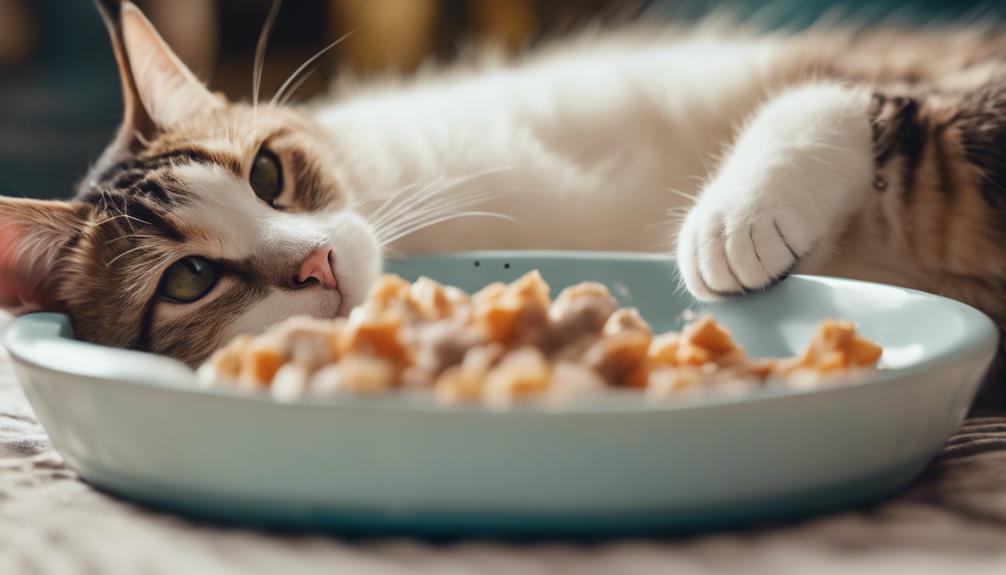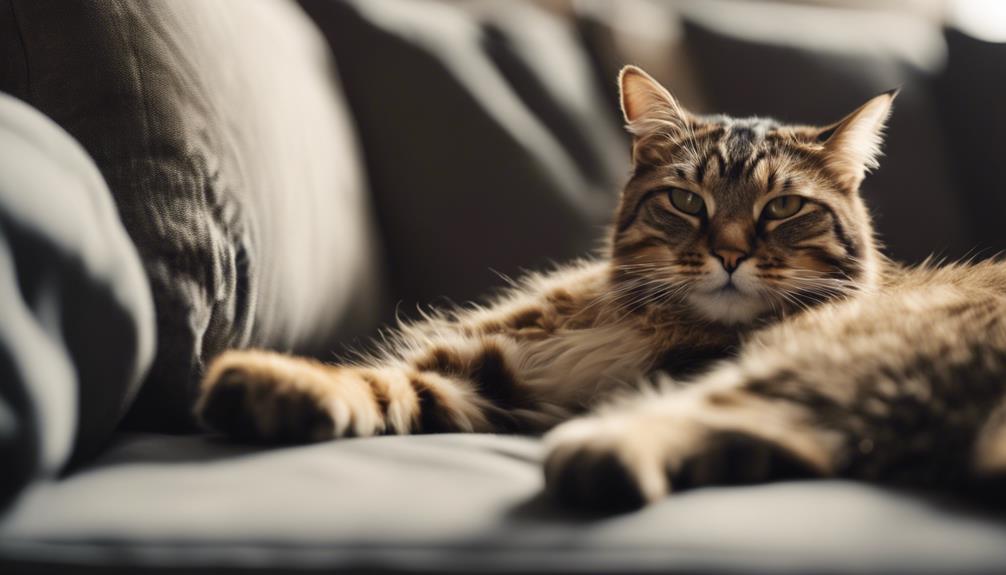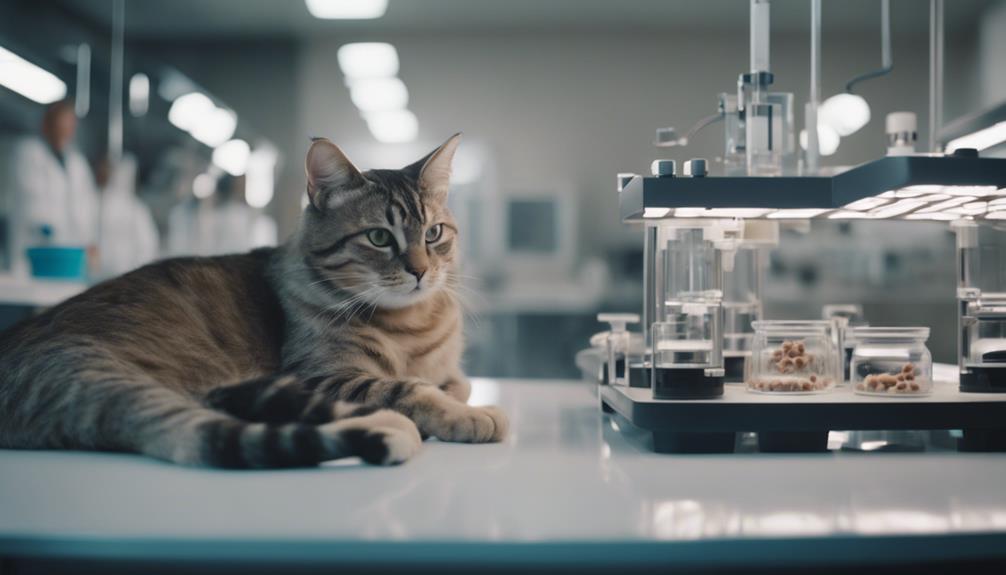The recent study exploring cats' attitudes towards food acquisition has unveiled intriguing parallels between feline and human behavior.
The notion that cats, like us, would prefer not to exert effort for their meals introduces a thought-provoking perspective on our understanding of these enigmatic creatures.
As we navigate through the implications of this study, we are prompted to reconsider conventional beliefs about cat behavior and the dynamics of their feeding rituals.
This revelation not only challenges existing assumptions but also opens the door to a deeper exploration of the intricate relationship between cats and their sustenance, setting the stage for a captivating journey into the world of feline culinary preferences.
Key Takeaways
- Domestic cats prefer easily accessible food sources to minimize effort.
- Cat behavior aligns with their solitary hunting nature for convenience.
- Cat owners can optimize feeding routines with automatic feeders for convenience.
- Understanding and accommodating cat preferences enhance their well-being and happiness.
Study Overview
In examining the topic of cats' food preferences, a study overview was conducted to investigate feline behavior when it comes to working for their meals. The study aimed to understand whether domestic cats exhibit a preference for food that requires effort to obtain versus food that is easily accessible.
Through observational methods and controlled experiments, researchers monitored how cats interacted with different feeding setups. Findings suggested that, similar to humans, cats displayed a tendency to choose the path of least resistance when it came to mealtime.
This behavior sheds light on the innate preferences of felines and provides valuable insights for pet owners seeking to optimize their cats' feeding experiences.
Cat Feeding Behavior Insights
When considering feline feeding behavior insights, a clear preference emerges among domestic cats for food that requires minimal effort to obtain. Cats, known for their independent nature, tend to favor easily accessible food sources over those that require physical exertion or problem-solving skills.
This behavior aligns with their natural instincts as solitary hunters who would typically prey on small animals without much effort. Understanding this preference can help cat owners optimize feeding routines by providing convenient access to food, such as using automatic feeders or placing food bowls in easily reachable locations.
Behavioral Patterns in Cats

Understanding the feeding behavior insights of domestic cats sheds light on their behavioral patterns, particularly in relation to their preferences for food accessibility and effort required for obtaining sustenance. Cats, known for their independent nature, exhibit a strong inclination towards easy access to food. They tend to favor readily available meals over having to work for their sustenance.
This behavior aligns with their natural instincts as solitary hunters who conserve energy for critical activities like hunting. Cats' behavioral patterns also reflect their selective nature, choosing food options that offer the most nutritional benefits with minimal effort.
Observing these tendencies can provide valuable insights into understanding and catering to the unique preferences of our feline companions.
Implications for Cat Owners
For cat owners, recognizing and accommodating their feline companions' preference for easy access to food can significantly enhance their pets' overall well-being and contentment. Cats, known for their independent nature, may not enjoy working for their meals. As a result, providing convenient feeding solutions can promote a stress-free environment for your beloved pet. Consider incorporating automatic feeders or puzzle feeders that dispense food easily. By doing so, you can ensure that your cat's nutritional needs are met while also catering to their behavioral preferences. Ultimately, prioritizing your cat's comfort and satisfaction when it comes to mealtime can lead to a happier and healthier feline companion.
| Benefits for Cat Owners | Supporting Details |
|---|---|
| Enhanced well-being | Easy access to food promotes a stress-free environment |
| Contentment | Automatic feeders or puzzle feeders cater to feline preferences |
| Healthier pets | Ensuring nutritional needs are met effectively |
| Improved owner-pet bond | Prioritizing cat's comfort and satisfaction leads to a happier companion |
Comparison With Other Animals

In assessing cats' food procurement preferences, the distinct aversion to working for sustenance sets them apart from many other animal species. Unlike some animals that engage in intricate hunting techniques or foraging behaviors to obtain food, cats exhibit a preference for convenience and immediate gratification.
This contrasts with species like dogs, who may enjoy the mental and physical stimulation of working for their meals through puzzle toys or training exercises. Additionally, primates such as chimpanzees and bonobos showcase complex problem-solving skills when acquiring food, emphasizing a stark difference in food acquisition strategies between cats and these species.
Understanding these variances sheds light on the diverse behavioral adaptations that have evolved across the animal kingdom in response to the challenge of securing sustenance.
Potential Behavioral Modifications
When considering cats' reluctance to engage in work for food, potential behavioral modifications may offer insights into addressing this unique preference for convenience and immediate gratification over more labor-intensive food procurement methods observed in other animal species.
One potential modification could involve the implementation of puzzle feeders or interactive feeding toys to stimulate the cat's natural hunting instincts and provide mental and physical enrichment during mealtime. Additionally, gradually introducing small challenges or obstacles in the food-seeking process may help cats to associate effort with reward, potentially shifting their behavior towards more active food acquisition methods.
Future Research Considerations

Exploring avenues for further investigation into cats' food-seeking behaviors and preferences could shed light on potential areas for enhancing feline feeding strategies and promoting greater engagement with mealtime activities. To delve deeper into this topic, future research considerations might include:
- Conducting studies on the impact of food puzzle complexity on feline cognitive development and overall well-being.
- Examining the effects of different feeding schedules (e.g., free-feeding vs. scheduled meals) on cats' activity levels and weight management.
- Investigating the correlation between food presentation methods (e.g., bowls, puzzle feeders, scatter feeding) and cats' mealtime enjoyment.
- Exploring the influence of food texture and temperature on cats' food preferences and satisfaction.
- Assessing the role of scent enrichment in enhancing cats' interest in food-seeking behaviors and mealtime engagement.
Conclusion
In conclusion, the study on feline mealtime dynamics reveals intriguing parallels between cats and humans in their preference for easy access to food. Much like us, cats show a reluctance to work for their meals, highlighting their natural instincts and behaviors.
This study offers valuable insights for cat owners, shedding light on the intricate relationship between cats and their food acquisition. Just as we appreciate convenience and efficiency in our daily tasks, cats also exhibit a similar inclination towards effortless mealtime experiences.




